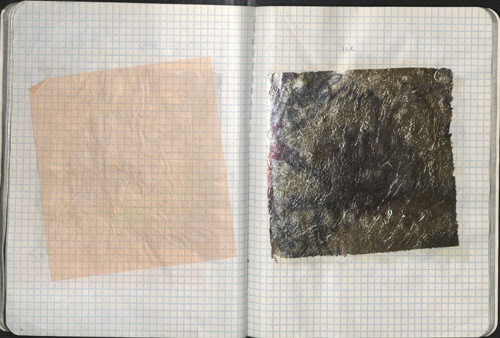the destroyer > art > editor's introduction
NOTES ON NOTES
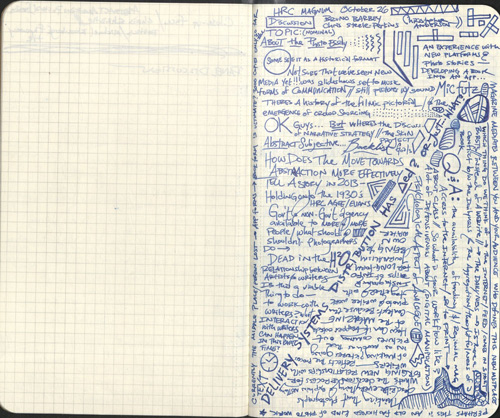
Over the course of a single day, Saturday, October 26th, I filled up four pages of a little brown notebook with notes.
Strike that – I filled up two pages. I left the other two mostly blank. But more on this later.
The occasion for my weekend sojourn into note-taking was a symposium entitled “Magnum Photos in the Digital Age” sponsored by the Harry Ransom Center in Austin, Texas. Concentrating on the living legacy of the cooperative photo agency founded in 1947, the symposium threw particular focus on the photographers themselves. A host of panels featuring luminaries of Magnum – Susan Meiselas, Bruno Barbey, Alec Soth, Alessandra Sanguinetti – consistently filled a large lecture hall to capacity throughout the course of three days of programming.
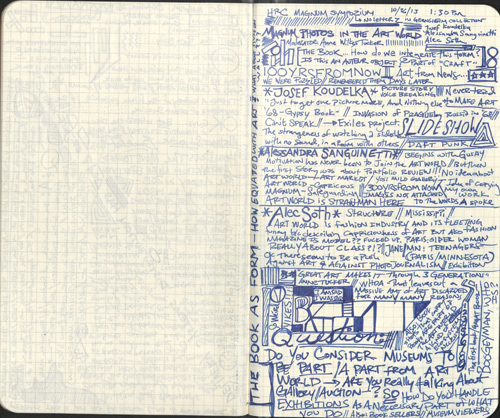
A confession: as Saturday’s events wore on I grew weary. Overstimulated? Understimulated? My notes index my repeated vacillation between boredom and excitement. I wrote: “The strangeness of watching a slideshow with no sound, in a room with others / / Daft Punk” during Josef Koudelka’s talk – one in which the septuagenarian curiously abdicated his own comments in favor of a rolling slideshow of his work, unaccompanied by music. I guess I admired the guy’s devil-may-care attitude (although truthfully, it read as exhaustion and resignation), but as per my note, I had more fun imagining a soundtrack to the dozens of overly-serious black and white panoramas.
Thus: Daft Punk.
My notes, it seems to me now in retrospect, were not only a method for me to organize the information I was passively receiving, but more importantly, provided a space to talk back. Particularly annoyed at a group of panelists (many with gallery representation) who wholesale dismissed the art world for its capriciousness, but waxed poetic about the fashion world, I scrawled in capital letters – sideways – “BOOGEYMAN, WHO IS?”
Sometimes I would ferret my displeasure to another page. Without identifying data I’m not even sure whose work or rhetoric I was not a fan of, “Like, AT ALL.”
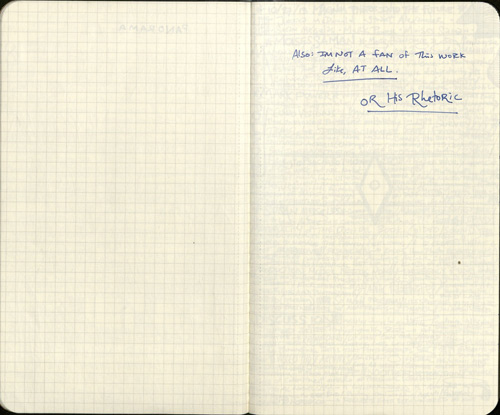
That’s the thing about notes: they tell you a great deal about the wrong thing.
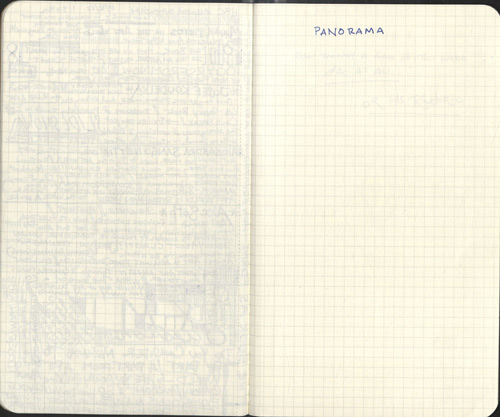
+++
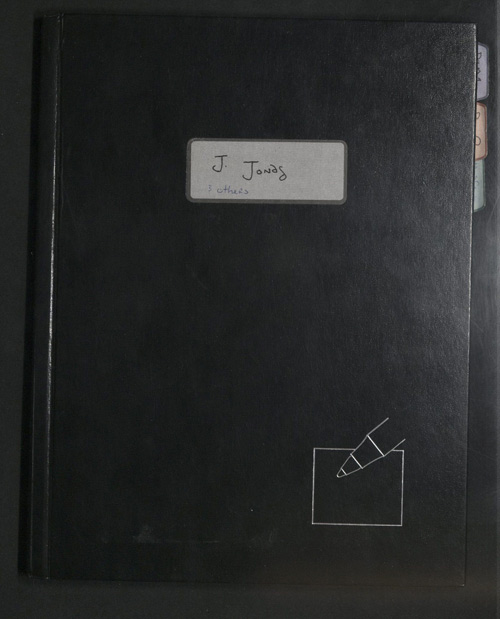
Another weekend event, this one more intimate: a performance workshop I attended, led by the artist Joan Jonas, is recorded in the first dozen pages of a black hardback notebook. The self-adhering sticker on the front cover is quizzically titled “J. Jonas & others.”
I remember Jonas gathering us around her, sitting us down, and telling us what she was thinking about. “Lists,” she said. “I’ve been thinking a lot about lists. I’ve been making many lists.” And because, let’s face it, it was her workshop, we made lists.
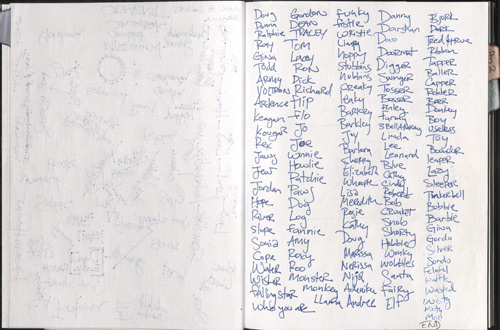
One list I made over the course of that weekend was simply a list of names: and I must say, my flow is astonishing. How I go from Doug and Donna to Wasted, Wisty, Misty Moe is beyond me. In between the beginning and end I listed people I went to college with, people in my family, slightly derogatory nicknames, the seven dwarves Walt Disney wish he had animated, and on, and on.
The performance I did at the end of the workshop had to do with that staple of grade-school divination: M*A*S*H. Of all the M*A*S*H lists I made in that notebook, the one without text is still my favorite, and I’m still not sure what to do with it. Probably nothing.
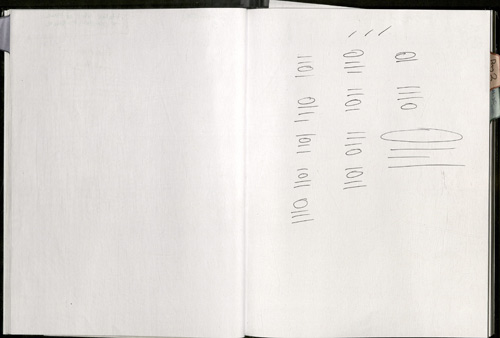
+++
Sometimes I can’t read my notes – not because my handwriting’s bad, but because of the way the notebook has aged. This is the case with one notebook from college – it seems the pages have gotten thinner, more transparent. And my choice of ink color then probably continues to make legibility worse today. Difficult information.
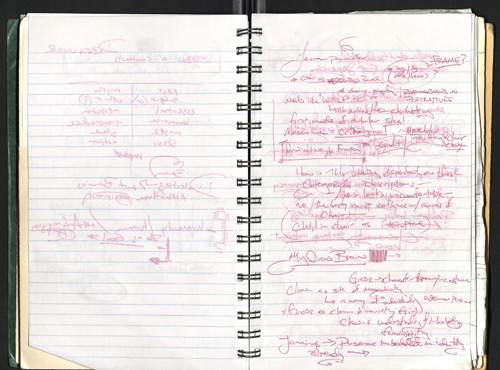
+++
I asked the artists in this issue of The Destroyer to send their notes, and collectively they’ve submitted an encomium on notes and note-taking.
Notes are pragmatic.
Like the notes of Sarah Frey, documenting her everyday tasks and missteps –a missed event is marked with “DIDN’T GO :(“. Frey’s running list of movies she’s watched is a veritable archive of material, high and low, from Antichrist to Hood Rats. The sloppiness and self-attack are practiced hallmarks of her style, and at least for me, are incredibly affirming.
Notes are sincere.
Sterling Allen’s sketchbook functions as a visual diary, filled with drawings, plans and lists. In fact, it was watching Allen sketching during an artist’s lecture we both attended that led me to solidify the topic of this issue. Here a library call number, there a strip of bacon.
Notes are possibility and its undoing.
Or at least they record a relationship to the future – as Christina Sukhgian Houle’s notes attest. A future-play, a future-business (many sited in the 23rd century) are amongst the many proposals Houle makes in her notes. Whether or not these projects are realized is somewhat unimportant – what matters is their relationship to visual thinking.
Notes are a kind of performance (or at least grist for the mill).
Josh Rios and Anthony Romero’s notes function as a work on its own terms. Connected to a series of performances conducted in and around art history classes, their re-framing and regurgitation of art history is at once playful and critical; for example, Robert Smithson, whose work is often connected with the active processes of environmental morphological change, is rebranded “INERT”.
Notes are self-referential.
One of Rios and Romero’s lectures is recorded in Sterling Allen’s submission – on a page filled with Egyptian motifs is a three-quarters back-view of Rios. There’s a relationship, always with the self, even when at work on something else:
“WIN,” says Allen;
“Me Me Me #6” says Frey;
“I melt on the stage in a puddle” says Houle;
“ssssssssseperateeeeeeeeeeeee” say Rios and Romero.
+++
There is fun to be had: in decoding, in reading through scratched-out lines, in distinguishing (or resisting the impulse to distinguish) between forms and plans, in deciphering what’s important (projecting is more like it), in the prospect of being a voyeur to someone else’s process.
One of the stranger things about being an art historian is that people misapprehend you as a failed artist – as though making art is what you really wanted to do, and studying its history was the consolation prize. I make art, but my attempts at it remain mostly secret – mostly in my notes. I like it that way.
What we do – artists and art historians – is similar but not the same. This is likely why I felt so discouraged at the Magnum symposium; the participants were not better historians of their work.
Wonderful, then, to find a space we share -
Analytical, aleatory.
